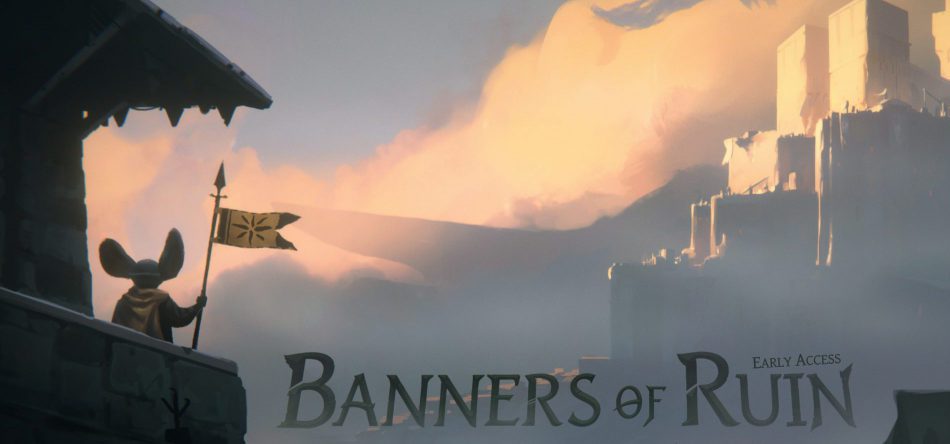While there are some good ideas here, they’re often overwhelmed by frustration.
Type: Single-player
Genre: RPG, Strategy
Developer: MonteBearo
Publisher: Goblinz Studio,
Maple Whispering Ltd.,
Mugen Creations
Release date: 31 Jul, 2020


Introduction
Fancy playing a weasel and a bear fighting for the Blackfoot resistance against the not-quite-all-powerful House Ender, and they’re wolves, rabbits, and other villainous creatures? Well Monte Bearo and their trio of publishers are giving you that chance with Banners of Ruin, the new Rogue-like deckbuilder / CCG, which has just entered Early Access on Steam this week.
Animals Everywhere!
Banners of Ruin’s setting is definitely interesting: like a typical low-magic fantasy setting, but populated with various species of mammal rather than the more normal humans and common fantasy races such as elves and dwarves. It’s not really explored significantly, though, which is a real shame; a few cards have certain effects based on race, but most are very rudimentary. There are no interesting species-related friendships or hatreds, for example, and the whole setting really just feels like a vehicle for presenting a fairly standard deckbuilder with some nice creature-based art.
At the moment the story, too, feels like a bit of a let-down, with little information provided regarding what’s actually going on with the Blackfoot and Ender. Who are they, what’s their history? Why are they fighting? Are they species divides or is there more to it? I want to know!
Of course, the game has only just entered Early Access, so all of this stuff may still be coming. If you’re hoping for a complete story, though, then at the moment you’ll be leaving empty handed.
Presentation
In spite of the shortcomings in the depth of the game world, the setting does, indeed, provide a good platform for some lovely creature-based art.
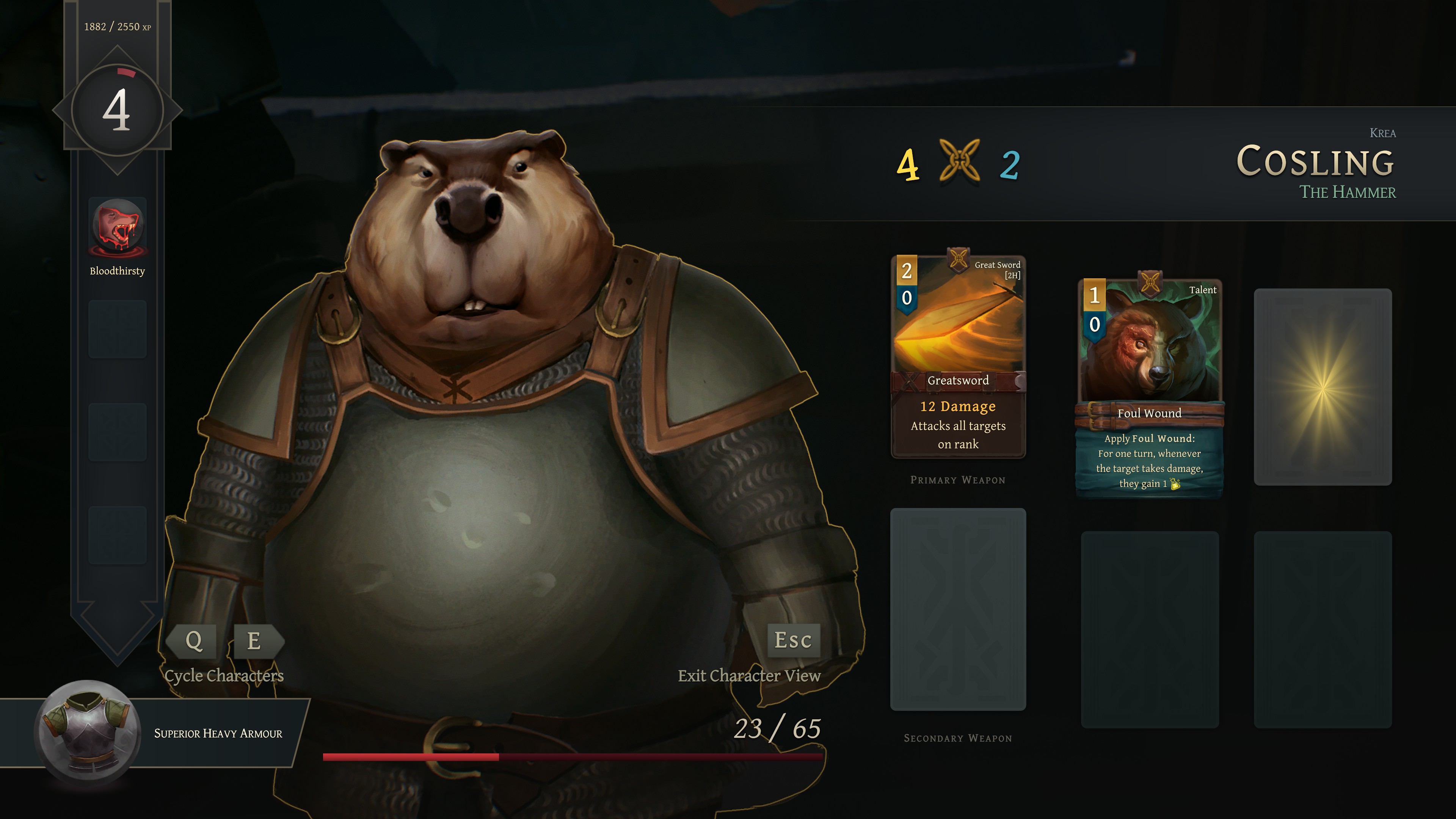
The style and implementation are weird. Most cards and the backgrounds and encounter art seem to have been drawn by a single artist, while a handful of other cards appear to have been drawn by a second — their style is completely inconsistent with the rest. That’s not necessarily a bad thing — Magic: The Gathering, for example, had plenty of cards from different artists with completely different styles — but given the range of cards available here, it seems like a bit of a missed opportunity for consistency.
The primary style itself is great, though I find it hard to describe. The animals are anthropomorphic, of course, and portrayed in a sort of traditional fantasy style. A wolf covered in a dark cloak looks brooding and dangerous; a bear wears leather armour that looks far too small for it, while wielding a massive battle-axe in one hand; and a wily mouse in thief’s garb stalks carefully up a dark alleyway. All these scenes and more are perfectly drawn and really draw out both the animal nature of each character and the anthropomorphism that’s being applied to them in order to make the game what it is.
The game has a sort of faux-3D look to it, with some great Live-2D style animations being used to great effect on the two-dimensional art. Encounters are very nicely presented, and combat — where you’ll be spending most of your time — looks rather good, too, though a few more fancy special effects wouldn’t go astray.
Images range from highly detailed scenes to characters in action over abstract backgrounds, but almost all of them are exceedingly well drawn. The primary artist has done a phenomenal job producing so much consistent, high-quality art — or if more than one artist was involved, they’ve been exceptionally consistent. Sadly this makes the lack of any real story or background and the few inconsistently styled pieces stand out all the more.
The UI is clean and mostly functional, though tooltips are inconsistently applied and the “…” on some dialogues (I noticed them in the tutorial in particular) seems somehow out of place. There’s a small handful of graphics settings and the game runs well and looks good in UHD. A few other options adorn the various menus, including one labelled “Telemetry”, which isn’t explained. I left it on. Sadly there are a number of grammatical errors, but I hope another editing pass is scheduled before the game leaves EA; it’s not much to worry about at the moment.
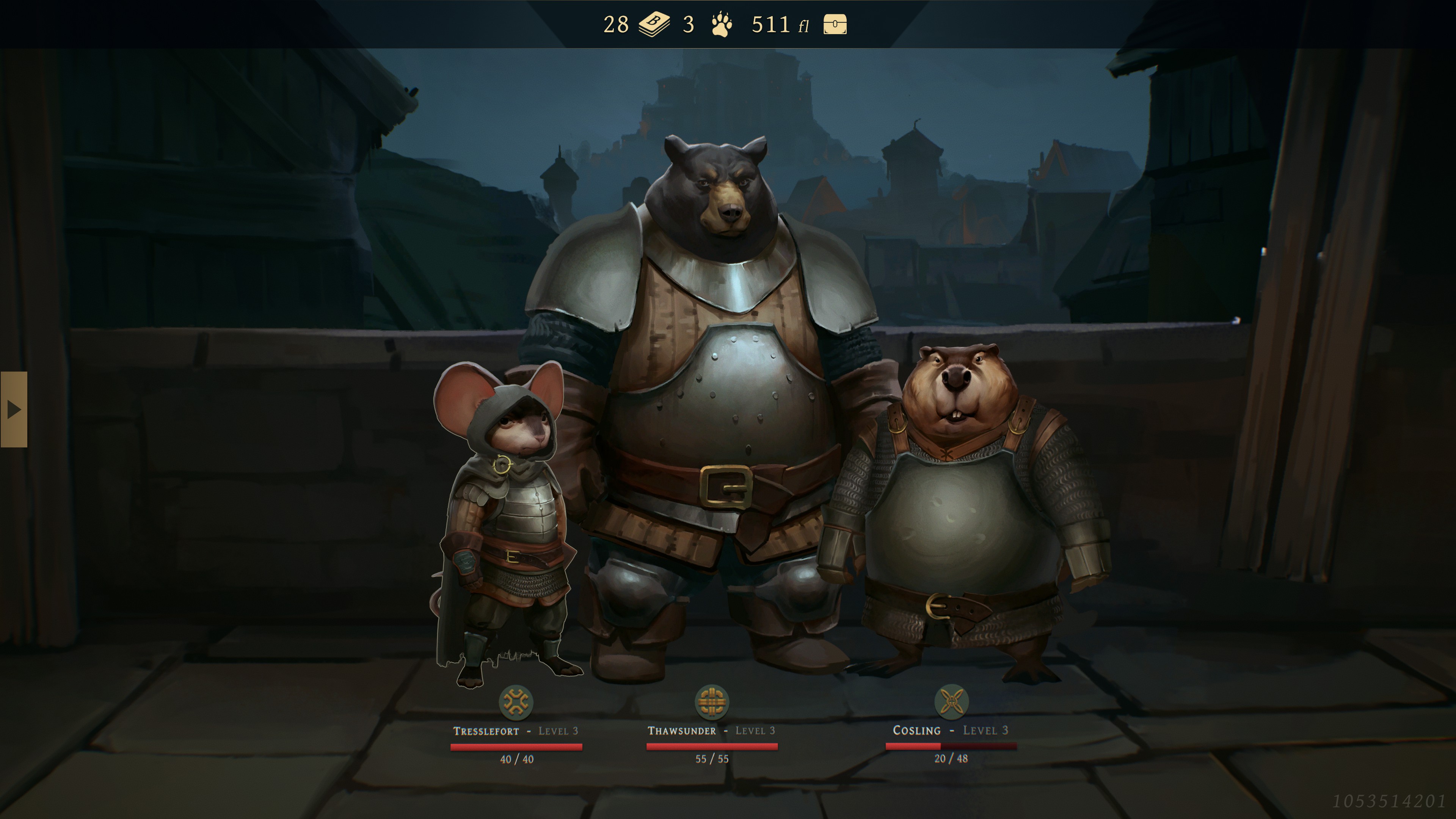
Sound effects are good: well normalised and they suit the game. I would have liked to have heard some animal noises, given the setting, but my dying weasel’s last hurrah was sadly lacking, and he disappeared silently. This could be an area for significant improvement — and potentially a lot of fun for voice actors!
Music is excellent, with a dramatic fantasy feel to it. There seem to be only very few different tracks, however; I found myself recognising the same tune often. There are also a number of screens with no music, the silence creating a stark contrast to the rest of the game. I’m hoping it’s simply not yet been added.
Gameplay
Banners of Ruin’s gameplay is essentially divided into two phases: street exploration and turn-based combat.
Each game requires that you complete three streets in order to reach the (ridiculously hard) big boss battle at the end, with each street having three possible lanes of advancement. Each lane is filled with 20 cards, the topmost being revealed. To advance along the street you select a card from the three available and either engage in combat or resolve the non-combat encounter (which can sometimes degenerate into combat anyway). You’re also able to look at your party’s characters and available cards, and adjust their battle positions, while in this mode.
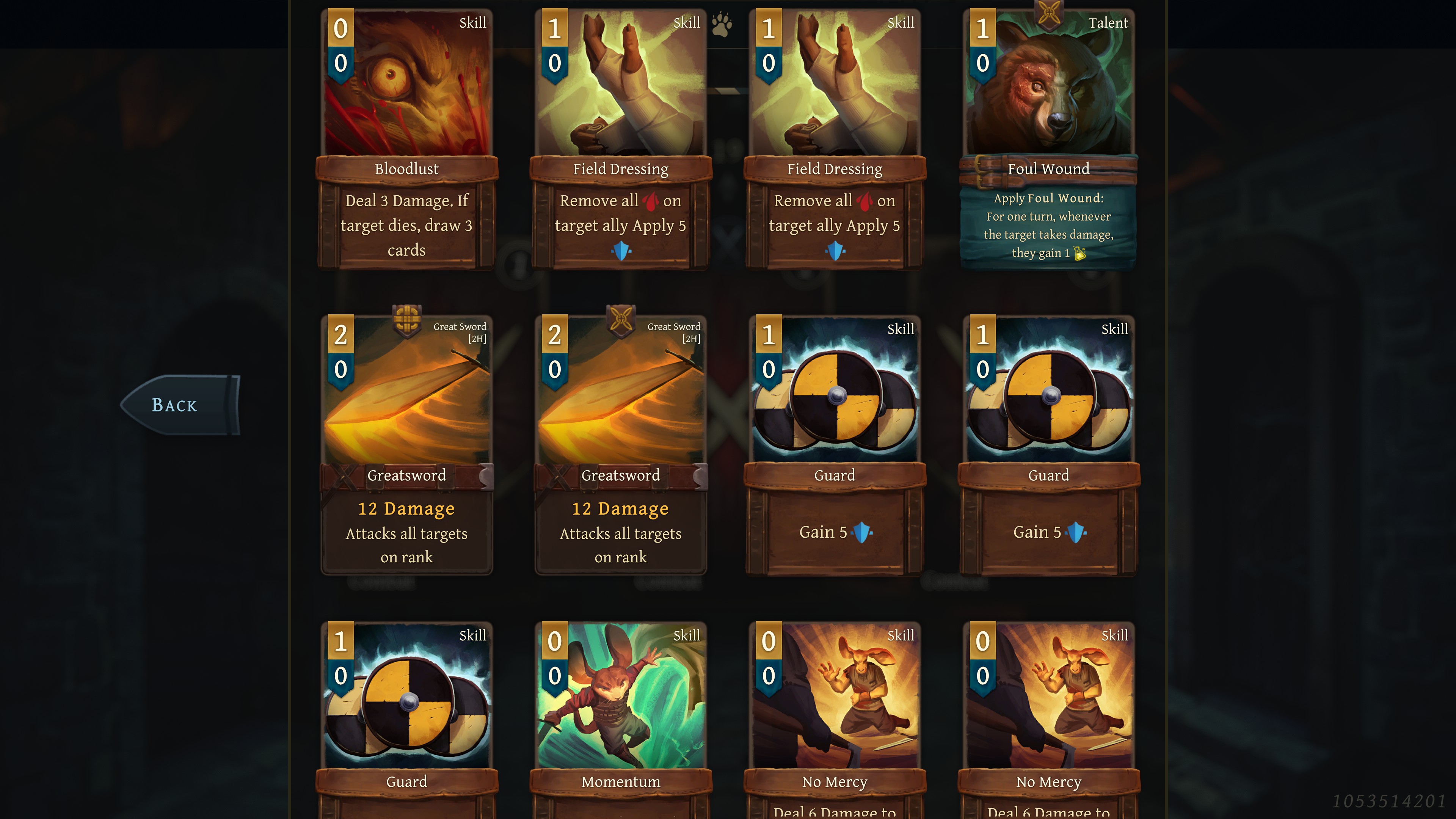
Non-combat encounters range from simple shops, to fighting dens, to altars, and a fair few more, but most are simply well-presented wrappers for adding a card, removing a card, gaining experience points (XP), or gaining health. They seem reasonably varied at first, but I found them repeating often across multiple games, and, at least from my experience with them, each one only seems to have a single result, so once you know the “correct” choice for the few encounters that offer one, there’s no risk in always choosing that choice the next time you see it.
Combat is the meat and potatoes of the game. This is presented in a “2.5D” view of a battlefield, with each side comprising up to three characters in each of two ranks: front and rear. The player always seems to have the first turn.
Each of your characters has a certain number of stamina and will points, with maximums that can only be increased through gaining experience and levelling up the character. You usually start at Level 1 with two stamina and one will. Current values are set to their maximum at the beginning of each combat. Once used, will is gone until restored by a card effect or you begin a new encounter. Stamina, however, replenishes every turn.
Each turn you draw five cards from your deck, plus another if you have a certain modifier active. If you run out of cards to draw then your discard pile is shuffled back in and drawing continues. Each card costs a certain amount of stamina and will points. Cards may be general use cards, which may be used by any character with the available stamina and will, or character-specific cards, such as weapons and talents, which may only be used by the designated character. Card effects are resolved immediately, making the order in which you play them critical to success; there’s no point playing a card that makes an enemy take increased damage from attacks this turn after you’ve already played all of your attack cards, for example. Your turn ends when either you run out of cards you want to play, or you have no characters with stamina and will available to play your remaining cards.
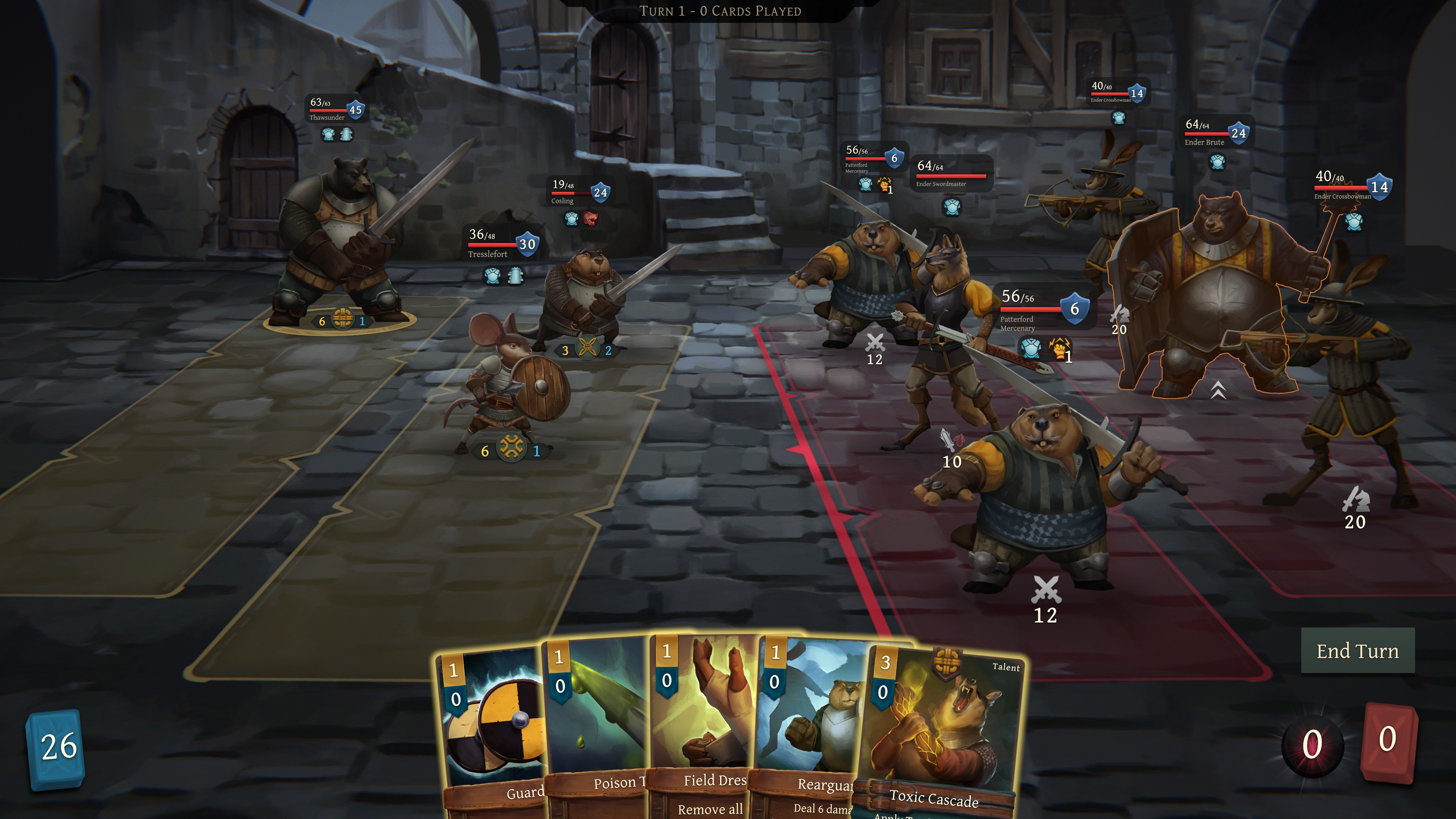
At the end of your turn you discard any remaining cards and play moves to one of the enemy ranks: front and rear act in alternate turns. (Some confusing tutorial information suggested that defeating the active rank before its turn made play move to the other rank, but this doesn’t seem to be the case; instead it gives you two turns in a row.)
A character is defeated if its vitality is reduced to zero, but characters also have armour to help protect them. Armour points are restored at the beginning of each combat, whereas vitality is only restored through healing. Healing is difficult; I think I’ve only seen a couple of cards that do it during combat, and encounters tend to be infrequent and expensive, though there are occasional exceptions to the latter. If one of your characters dies then for the remainder of that battle that character’s cards become useless, blocking up your hand and making the rest of the combat more difficult. The cards are permanently removed from your deck after the battle.
Damage from cards can be direct attacks, which typically subtract from any remaining armour points first before reducing the target’s vitality, or indirect, such as poison or bleeding, which do damage over time. As is typical for the genre, there are many modifiers that can be applied to characters due to card effects, both buffs and debuffs, and the key to winning battles with as little loss to your own team as possible is using these effects efficiently. A battle is won when all enemy units are killed, and lost if all friendly characters die. You then either return to the street or return to the main menu, depending on which it was.
Back on the street, once you empty at least one lane of cards, you reach the end of the street and the boss-level encounter thereafter. Do that three times and you reach the final boss. At least, I think you do; I haven’t managed to beat that one yet.
Combat wins and certain encounters provide extra cards to choose from and XP to improve your characters. Each level up you can increase either stamina or will by one point, as well as unlock either a new talent or passive ability — these alternate with levels. Combat experience is shared between all characters in your party, so smaller parties level up more quickly. That said, the maximum level is only eight, so you don’t have too far to go regardless.
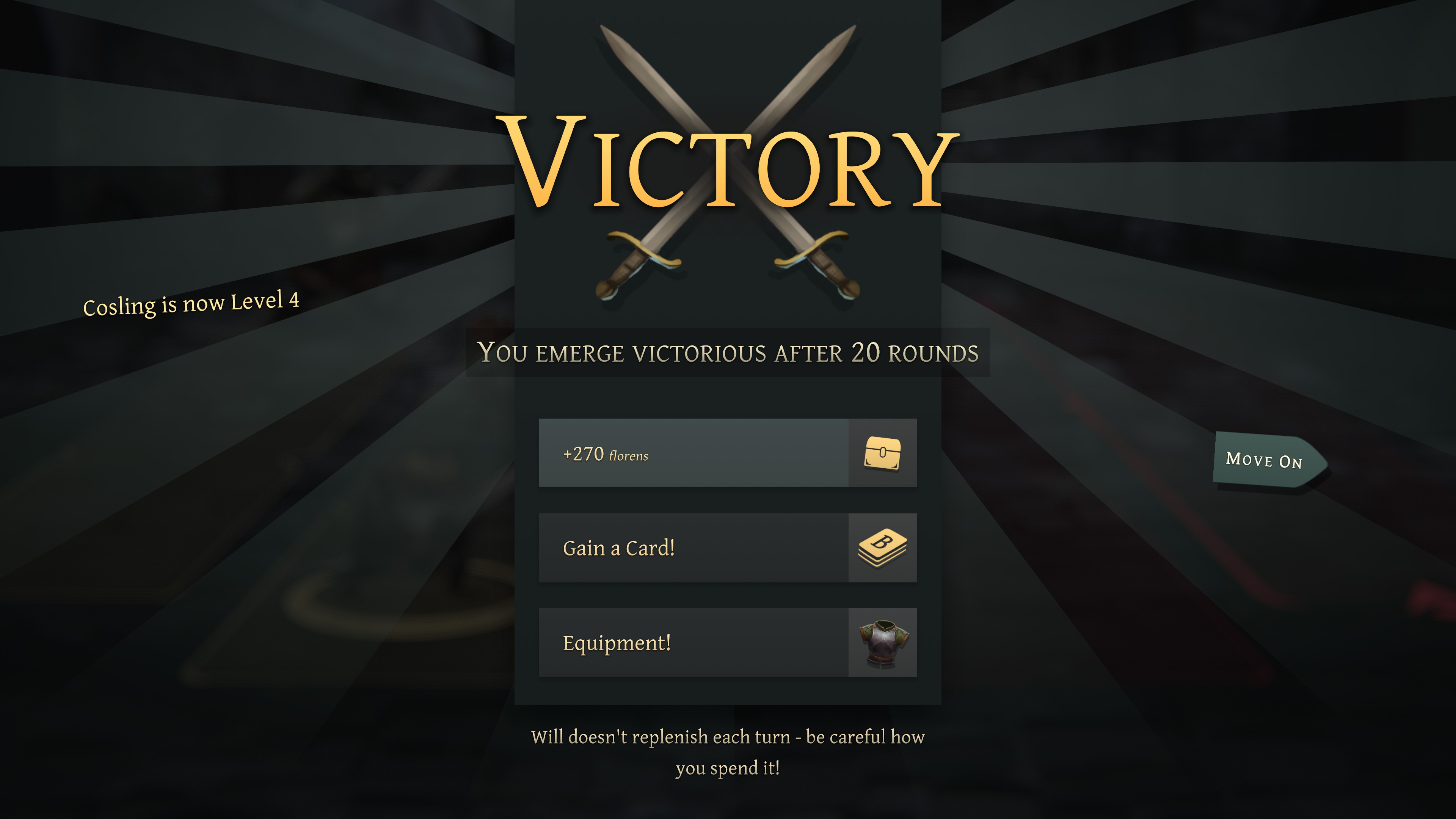
The game uses Rogue-like elements in a fairly typical way for the genre, with permadeath and procedural generation, and also includes meta-progression — or permanent improvement between “runs” at the game — through “unlock tokens”, rewarded depending on your performance in the run. These can be used to unlock three passive abilities and three active cards to appear randomly in future runs, in each of three different streams: warrior, priest, and rogue. There are only a few truly game-changing things in here, though, and some of the others seem worse than many of the normal cards. But it’s a good start.
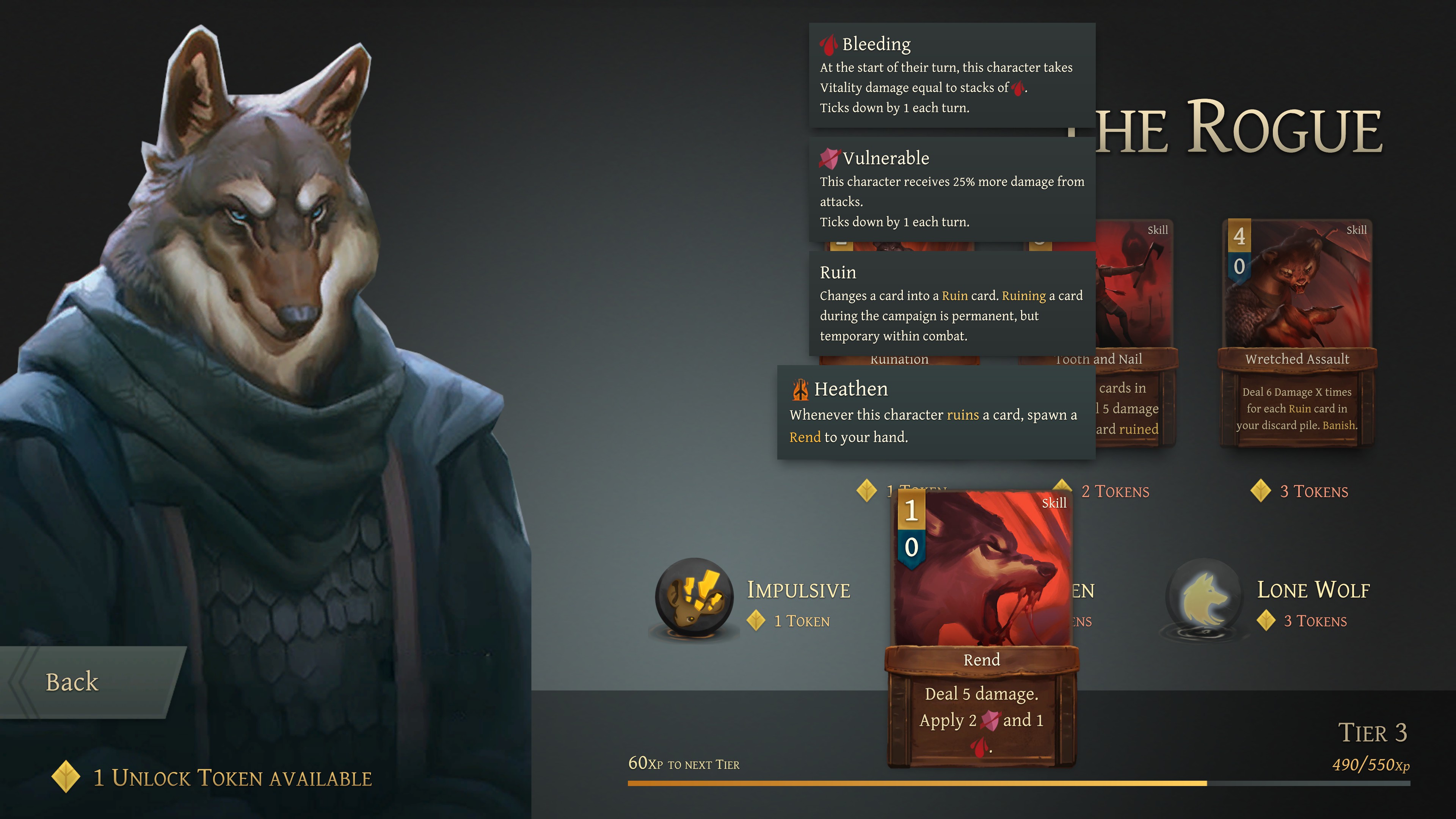
There are currently two selectable campaigns, but on the surface, at least, they seem to be the same except for the starting two characters, and, of course, the cards that go along with them.
Current State of the Game
As the game stands currently, it feels rather unfinished.
As I mentioned earlier, the setting isn’t explored in any depth and there’s no history or story provided. The core gameplay loop of street exploration and combat is in place, however, and there is some meta-progression, though what’s here is rather limited in scope and feels very grindy to unlock. Expect to play a LOT of fairly repetitive hours if unlocking everything is important to you.
The game itself has a number of issues, which is fine for an EA game, but they do still detract from enjoyment of the game. These range from minor issues such as missing tooltips or non-working buttons; to some abilities or cards simply not doing what they say, such as Pestilence not working at all and Venom not being applied every turn or not increasing every turn, or the Crossroads encounter not doing what it says. Oh, or certain UI elements choosing to stop responding to mouse input; that’s always a good one! There are also some of those typically silly CCG situations, such as Venom being reduced by armour and Charge not being applied to Shrapnel’s secondary attacks.
The game has some serious balance issues, with certain tactics being far more effective than others, effectively railroading you into only a few different types of deck builds if you want to do well. To make it worse, the boss battle at the end of the third street is such that if you don’t have a way to decrease an opponent’s Charge, after a few turns you’re likely to be taking over 100 damage per attack just from one of the five enemies in the battle, which means even the strongest team doesn’t stand a chance. It’s a cheesy way to make the game more difficult and I found it extremely frustrating to end a great run with this discovery.
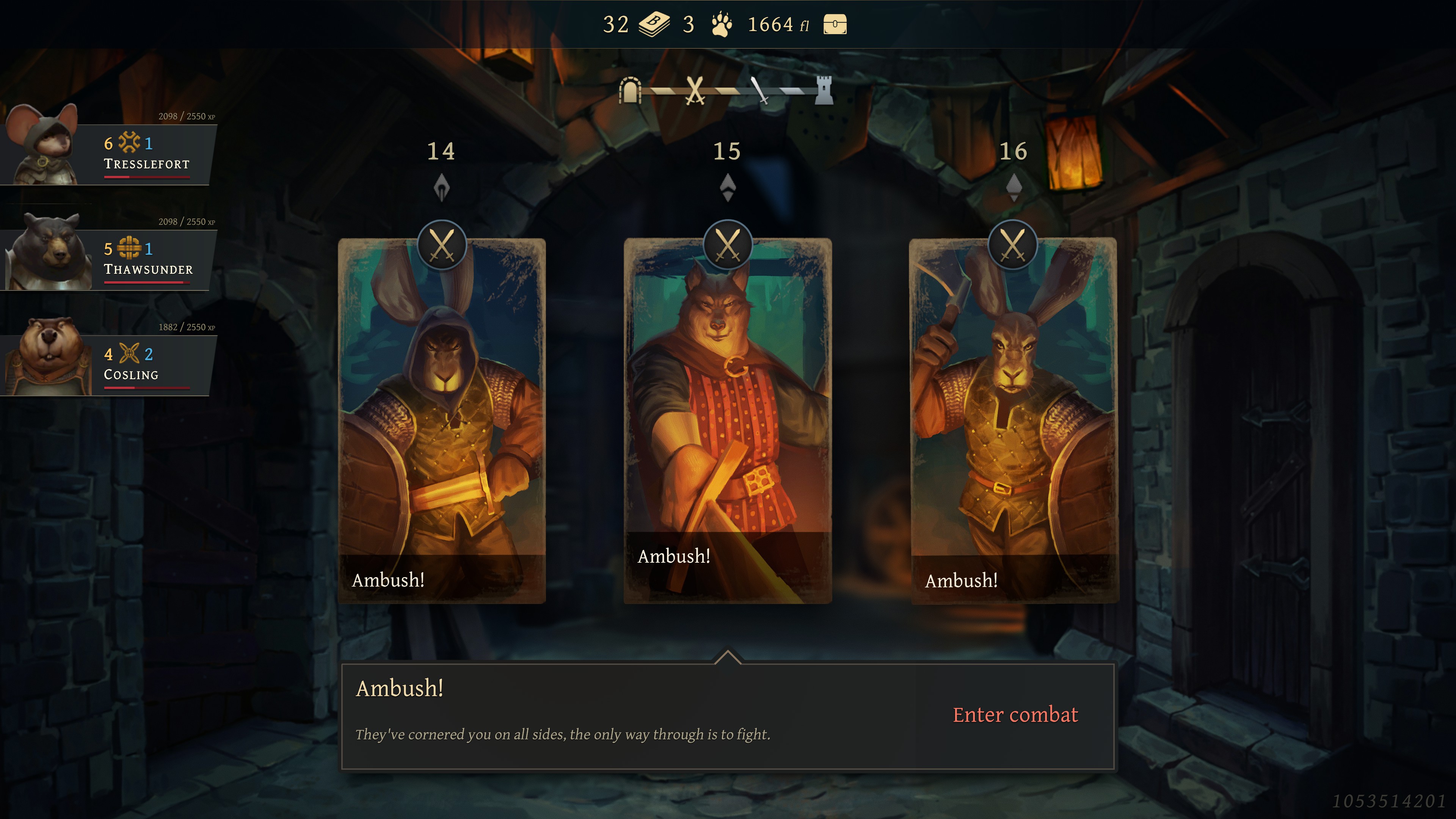
Compounding the balance issues, the street-level view doesn’t always give you a real indication of enemy strength. A simple “combat” could be a few easily dispatched rabbits or a couple of ranks of armoured wolves. You can usually depend on Elite combats being significantly harder, but some idea of the number and make-up of your opponents before clicking on the card and starting the battle would be good.
Probably most important to my enjoyment of the game, though, is how stale everything feels by the time I’ve reached the second street in any particular run. The level cap is too low for a small team to continue progressing, but the hand size is too small to make a team of more than two characters feel efficient; RNG just kills you. So you’ll typically end up with a deck that only requires minor changes from around the middle of the second street, making most of the remaining play just crossing your fingers and hoping nothing bad happens while you reach maximum level and get to the final battle. The limited hand size with only very few options to temporarily increase it (and those dependent on RNG) makes a bit of a mockery of the level increase system anyway; by the time you’re about level five, having more than one character in your team is almost always going to leave you with stamina to spare each turn.
Equipment, too, is especially limited; I got Superior Heavy Armour for both characters in my team in the first encounter the first time I played, and simply never bothered with anything else. The lack of card improvements also hurts the game in this regard; there’s no way to upgrade a card.
To make it worse, the fairly small range of everything makes the game become very repetitive very quickly: cards, enemy types, encounters, … . It just feels as though there’s not enough here to hold my interest for long enough to want to expend the effort taken to complete the campaigns, let alone unlock all of the permanent improvements.
Verdict
While I’ve actually mostly enjoyed my time with Banners of Ruin — interspersed with frequent bouts of frustration — the current content and asking price are a little too mismatched for me to be happy recommending it in its current state. That’s not to say I don’t think it will ever be worth the asking price; just at the moment, if I’d bought it, I wouldn’t feel as though I was getting my money’s worth from the game. I really hope it improves overall, though, because some of it is really good.
If it were half the current price or the genre was underpopulated, then I’d offer a more enthusiastic recommendation — though it would definitely need significantly more content and considerable rebalancing, regardless — but at the moment I’d suggest holding off and seeing where the game goes. Maybe play one of the many other excellent established Rogue-like deckbuilders available for less money while you wait.

